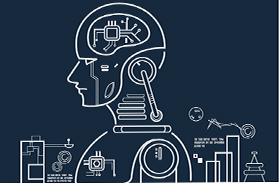 The indicators of what makes a company successful are changing rapidly, and organisations are turning to artificial intelligence to measure and analyse performance. But does the technology work – and does it suit all sectors?
The indicators of what makes a company successful are changing rapidly, and organisations are turning to artificial intelligence to measure and analyse performance. But does the technology work – and does it suit all sectors?
The majority of a company’s long-term value is now reflected in intangibles – indicators such as innovation, social impact, customer service, trust, security, sustainability and corporate governance.
That means there’s an increased need to measure these attributes – something that’s not easily done in an accurate and meaningful way.
Christina Larkin, Oceania Assurance Digital Trust Leader at EY, and Jeanne Boillet, Global Assurance Innovation Leader at EY, agree that profit and loss are no longer the sole indicator of a company’s strength and success.
In an EY thought leadership article earlier this year, they stated that companies’ priorities “are no longer just about maximising profits – but that transparency, sustainability and inclusion are increasingly part of the overall measure of success”.
“Failure to factor in these elements when assessing long-term value could have an impact on investment, recruitment, reputation and, ultimately, productivity and profit,” Larkin says.
“We live in an increasingly engaged climate where stakeholders demand more information across a broader spectrum. And in a digital world, they want this data to be up-to-the-minute and readily available.”
The AI factor
So in what ways can artificial intelligence (AI) help organisations quantify progress and success?
One clear benefit is the ability AI has to drill down into multiple layers of data to produce meaningful answers.
As Larkin points out, the data in our global digital universe is doubling in size every two years. Through AI, the analysis of colossal amounts of information can be both instant and bespoke.
For instance, it can be used to analyse a large volume of patents and classify them into ‘qualitative clusters’, she says.
Predictive analytics can also help analyse market and consumer behaviour, to provide trends and forecasts. AI technology can accurately measure – in real time – issues such as financial value, productivity and production rates, staff performance, cost management and sustainability.
In the past, this would have been too costly and time-consuming – and taken too long to give a real-time picture. Also, historically, data collection was of mixed quality and accuracy, and there was little framework to the process.
Human touch
With such complex levels of data and so many different value indicators, embracing AI is far from straightforward – and some areas are far easier to measure than others.
Larkin suggests that, going forward, companies’ ability to use AI to generate real-time key performance indicators (KPIs) will help to drive real-time outputs.
But the onus, she explains, is on organisations’ ability to establish the KPIs that are most appropriate – and then ensure these KPIs can be traced back to the right source to make them measurable.
The power of network analytics within HR is a good example, according to Larkin. New social mapping platforms can use staff surveys and metadata from staff phone calls and emails to see how effectively people are working and communicating.
Larkin suggests that, as well as identifying potential misconduct, these platforms – if used properly – could help improve productivity, identify innovation and foster a more collaborative culture in a business.
The same applies to email monitoring and video conferencing – AI can analyse tone of voice, body language and use of words to identify whether staff are ‘on message’ with the company ethos.
But, Larkin suggests, success in this area depends on getting the balance right between identifying areas where staff engagement can be improved and what could be construed as spying on the workforce – which could be counter-productive to motivating, developing and retaining employees. That’s where human judgement and control comes in.
Martin Keelagher, CEO of Agile Automations, which helps businesses transform their business processes, sometimes through AI, agrees that there are benefits to be gained from using AI to measure employee performance.
He emphasises, however, that the value of the outputs very much depends on the data being mined and the specific areas being focused on.
There’s a danger that in areas such as staff performance, he adds, the benefits from the information provided might be questionable.
“It is possible to track keystrokes, for example, so you can monitor whether someone is more productive at 9am than 4.30pm. But is that useful information and does it fit in with GDPR? There is also an ethical consideration here.”
Analysis revealing that staff are not happy, he says, is not in every instance going to add value to the business.
For a call centre, for instance, where staff turnover is high and the nature of the job is repetitive and entirely phone-based, the benefits of gauging job satisfaction levels through analytics are debatable.
Some sectors are able to incorporate AI better than others; some need more ‘hands-on’ human involvement, Keelagher adds.
“Retailers, for instance, are in a position to adopt a much more hands-off approach. But in sectors with far more regulation, such as banks and financial services, automation is most effective when paired with human involvement and sign-off.”
 A matter of trust
A matter of trust
Keelagher agrees with EY’s Larkin and Boillet that the value of companies today is gauged on far more than profit alone. He believes that the new battleground for companies is customer service – the need to be favoured by consumers and respected for all manner of values.
He says this is an area where AI can really help, by being used to measure levels of trust in companies.
Trust analytics takes unstructured data, passes it through a model, creates numerical scores and then compares that to financial performance. A high trust rating reflects positively on customer retention, pricing power and competitive advantage.
Demonstrating a correlation between trust and financial performance is an important step and provides an economic incentive for corporates to behave in a way that instils trust – be that from a transparency, social, sustainability or governance perspective.
When it comes to sustainability, AI can also play an important role in a company’s energy consumption. AI is able to process large amounts of data to optimise energy efficiency during production. Google, for example, has used AI to reduce the energy needed to cool its data centres by 40%.
Combining AI with big data analytics makes life much easier for those tasked with compiling and checking reports. AI can provide forecasts and spot patterns in data more quickly and without the risk of human error from mental fatigue.
As Keelagher is quick to point out, AI also works 24/7, takes no days off and doesn’t make mistakes.
Security services
AI is also increasingly being used to support businesses in the identification of security threats and breaches. Companies’ growing commitments to technological enhancement and digital developments bring with them security risks – and any kind of security breach in the modern world can spread rapidly and severely damage a company’s brand and reputation.
There is a pivotal role for AI here. It can screen for software abnormalities that help cyber criminals attack companies. It can also detect malicious software installed by hackers.
Once again, it is the speed at which AI works that makes it so much easier for IT teams to monitor the constant and increasingly sophisticated attempts by hackers to breach security.
One cyber security specialist tells BL: “Companies realise that if they are faster in detecting an attack, they have a business advantage. From a security standpoint, there is now a huge amount of data to contend with and AI is the only effective way to detect behaviour that’s deviating from the norm.”
AI in a post-Covid world
If business success is to be assessed on multiple factors other than profits – notably customer/supplier engagement – what impact, if any, will Covid-19 have on development of technology?
Keelagher says major events such as world wars have sped up technological developments, and the same is likely to happen with this crisis.
“How we utilise technology will change as a result of lockdown,” he says. “There is a realisation that you don’t have to travel to meetings – you can just jump on a Zoom, Skype or Webex call.
“We may see this impact on recruitment too – does a candidate really need to get on a plane to travel to a face-to-face interview? Lockdown has forced recruiters to interview remotely. Not only is this effective but it saves time and money.”
Lockdown also appears to be changing consumer perceptions with regards to how they communicate with a provider – and that may lead not just to further adoption of technology, but AI specifically.
Chatbots, for example, are increasingly an option for businesses to adopt, and they rely on AI to work. Chatbots can answer customer questions outside business hours or during extremely busy periods. They can establish the customer’s problem, then deal with it via pre-programmed answers.
They can also identify the small number of queries that require a personal approach, and pass those on for human beings to handle accordingly.
“People are talking to chatbots in a way that they would never have done before lockdown – and the more they are used, the more effective they will prove,” Keelagher argues.
Getting swift answers to queries via chatbots boosts customer satisfaction and thereby provides an incentive to choose – or stick with – one provider over another, he adds.
AI might not solve all the challenges faced by companies in the 21st century. But, as Larkin says, it is the enabler that supports the generation and analysis of new metrics – whether that be in innovation, customer trust/experience or employee engagement.
Those who embrace AI in this way will not only have a clearer idea of where they currently stand, but also where they are heading in the future.